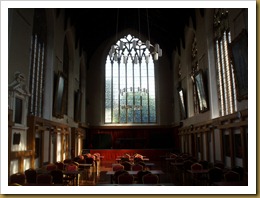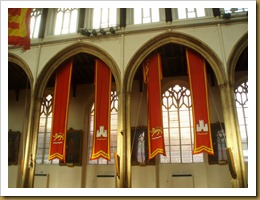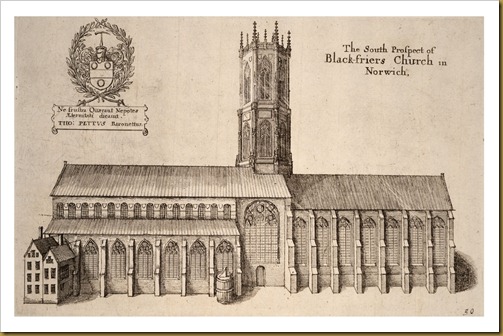
I’VE JUST completed my “Over the Water” chapter, meaning that I’ve moved south of the river for the first time into the heart of Norwich. My first job here is a potted history of the buildings around St Andrews Hall. I’ve probably got a bit carried away – 700 words and counting. Here goes:
Up in Yorkshire at Rievaulx Abbey and over in Wales at Tintern, tourists flock to see the splendid ruins of buildings destroyed by the aftermath of the Dissolution of the Monasteries.
Here in Norwich we have a set of very similar buildings which survived that same 16th century trauma. But because the St Andrews Hall complex comes complete with roof and windows, very few people seem to realise its importance.
OK so the busy city centre location in Norwich doesn’t quite compare to the desolate splendour of Tintern et al, but nevertheless my main point holds: while the vast majority of monasteries and friaries were plundered and pillaged after Henry VIII made his fateful decision, the clever burghers of Norwich managed to buy these buildings en bloc for the city. And as a result St Andrews offers historians the most complete remains of a friary in the country. 
As many as 60 Dominican friars once lived here. Pre-reformation, these so-called Blackfriars were just one of a a number of monastic orders in the city. Elsewhere the Carmelites, the Franciscans, the Benedictines and the Augustinians also enjoyed huge influence. But with the exception of the Benedictines at the cathedral, don’t think of them as monks hidden in cloisters. Most were “mendicant friars”. In other words people who preached their faith and begged for alms on the streets. This is Terry Adkin’s summary from the Norwich HEART website:
“As well as teaching the local people the friars also had schools for educating their own members, preparing them for ordination to the priesthood. Many of the friars attended the universities at Oxford and Cambridge, whilst some studied at universities on mainland Europe. Their schools in Norwich were of a very high standard and attracted scholars from other parts of the country and Europe. A future pope, Alexander V, himself a Franciscan, attended the Norwich Greyfriars‘ school before going on to Oxford. The friaries had extensive libraries, and many of the Norwich friars became authors of international repute.”That whole religious and cultural landscape was shattered in the 1530s when Henry VIII dissolved the monasteries. Within a generation many grand buildings simply disappeared; the land re-used by new owners, the stone re-used by new builders.
So all the more credit to the city fathers who saw the way the wind was blowing and moved quickly . Specifically quoting the importance of the Blackfriars’ city centre location, they asked Henry VIII for permission to buy it to 'make the churche a fayer and large halle, well pathed, for the mayor and his bretherne... for their common assemblyes...” The king agreed and the rest is civic history.

The nave of the friars’ vast church became The New Hall, a venue for feasts and courts. Now called St Andrew’s Hall, it is best known for its music and beer festivals. The chancel of the church at first became a municipal chapel. Now called Blackfriars Hall it’s used for concerts, conferences and banquets.
The buildings which survive today sprang up from the remains of a fire in 1413. By then, as historian Helen Sutermeister says, “it is clear that the furnishings of the church had departed far from the austerity advocated by St Dominic himself.”
To the north of the nave lay a cloister with the full panoply of monastic buildings; a kitchen, a chapter house, a frater (refectory) and dorters (sleeping quarters). Many of those buildings survive within the Norwich University of the Arts campus.

A central tower above the old nave and chancel fell down in 1712. According to Sutermeister it was “octagonal, crocketed, faced with freestone and decorated with armorial bearings …the most elaborate part of the whole building.”
It’s a strange but wonderful building to wander around in today. (And remarkably you still can normally wander around it, even if it isn’t formally “open”.) Mostly civic, with a whiff of the spiritual it is a strange amalgam. But take your pint at a beer festival or your seat at music festival and it really does come alive. St Andrews is one of the buildings that truly makes Norwich special.